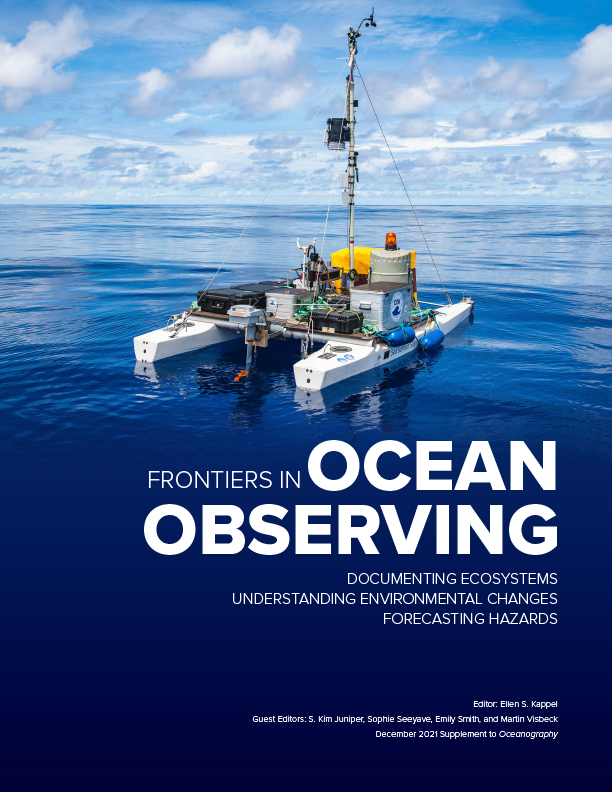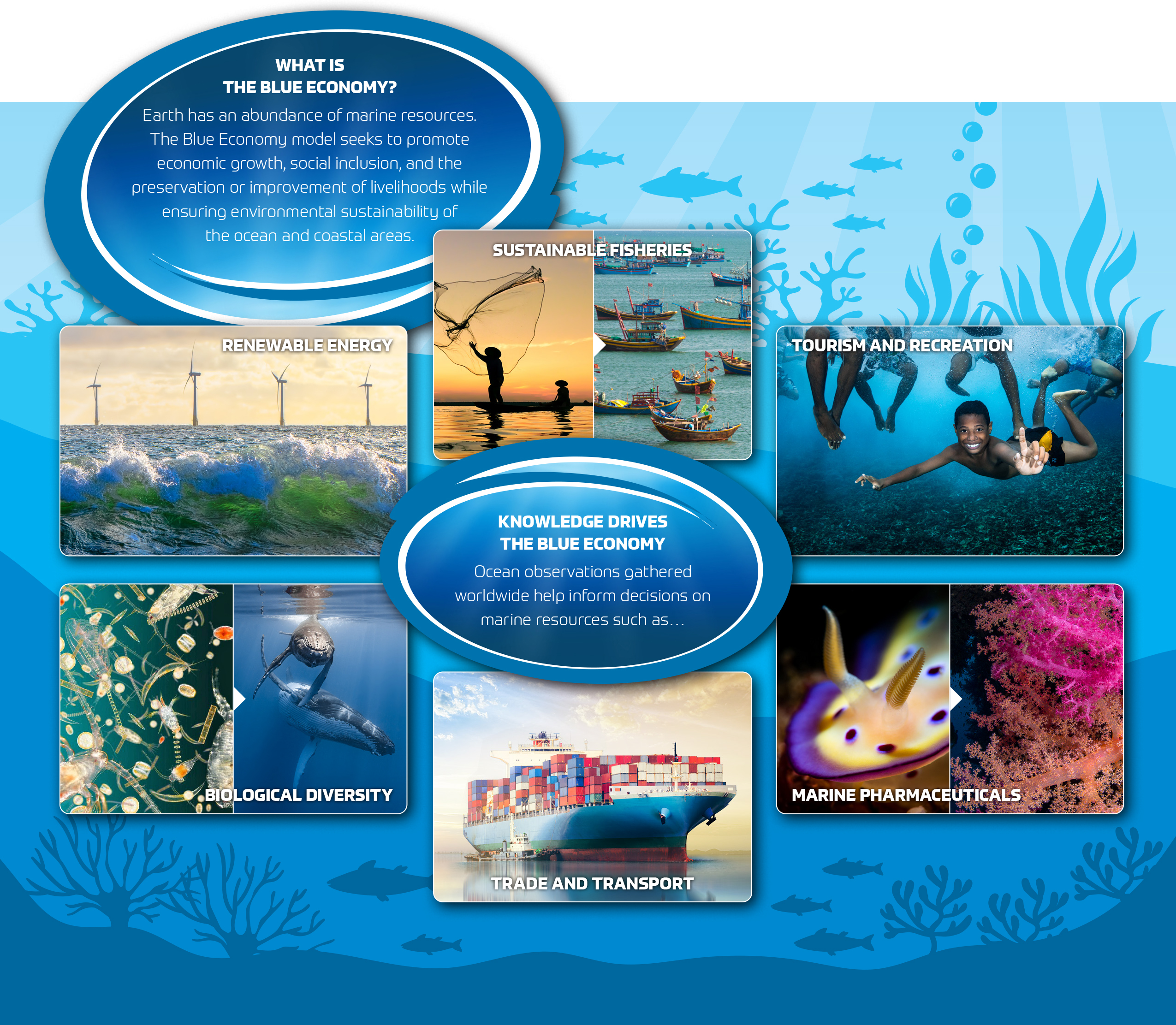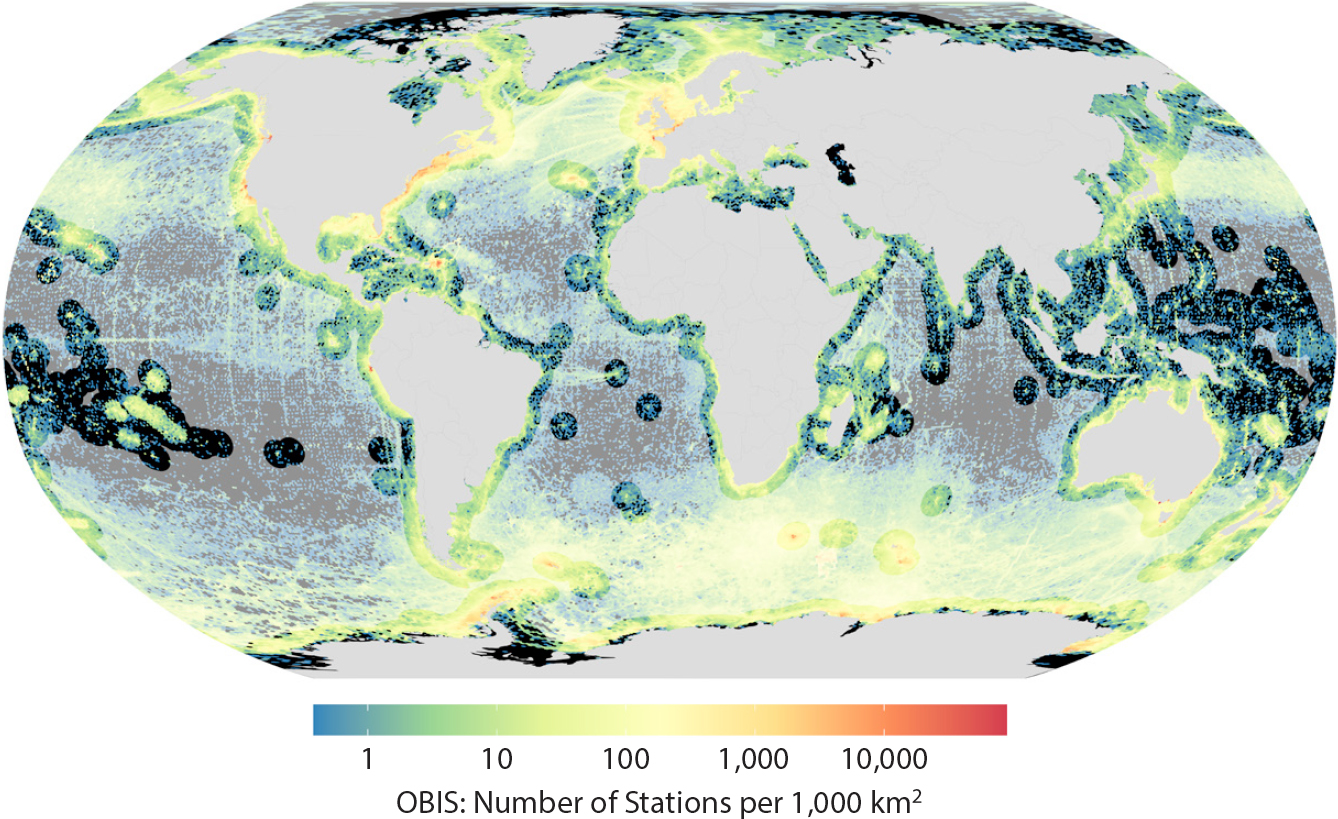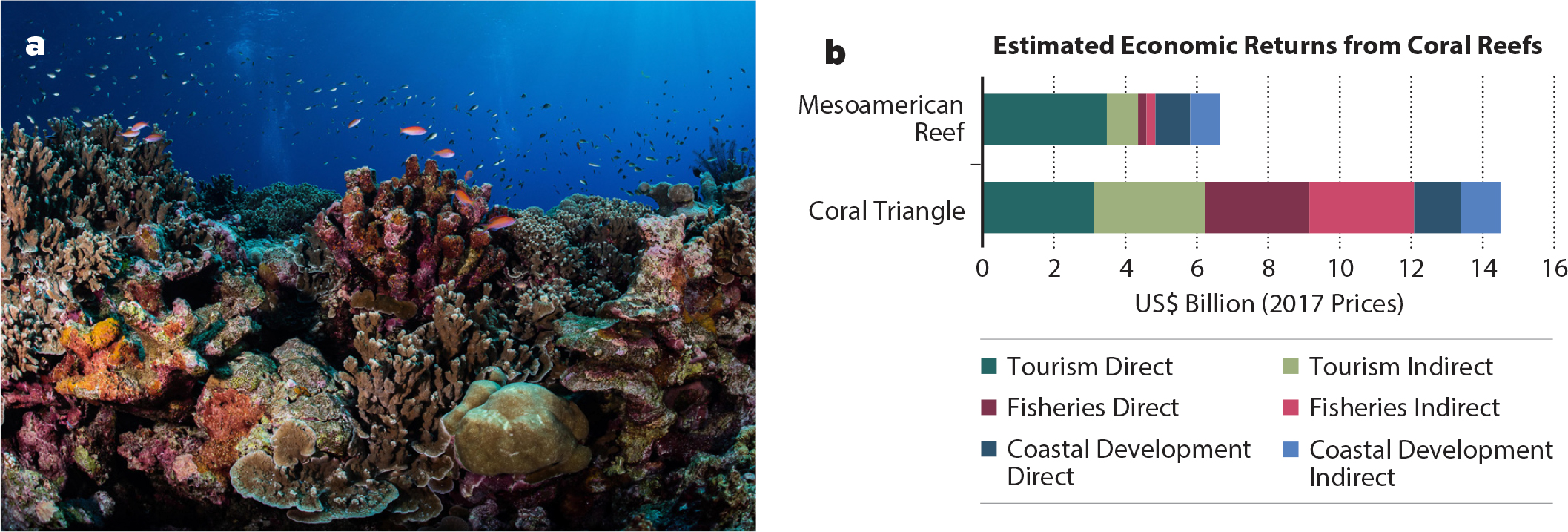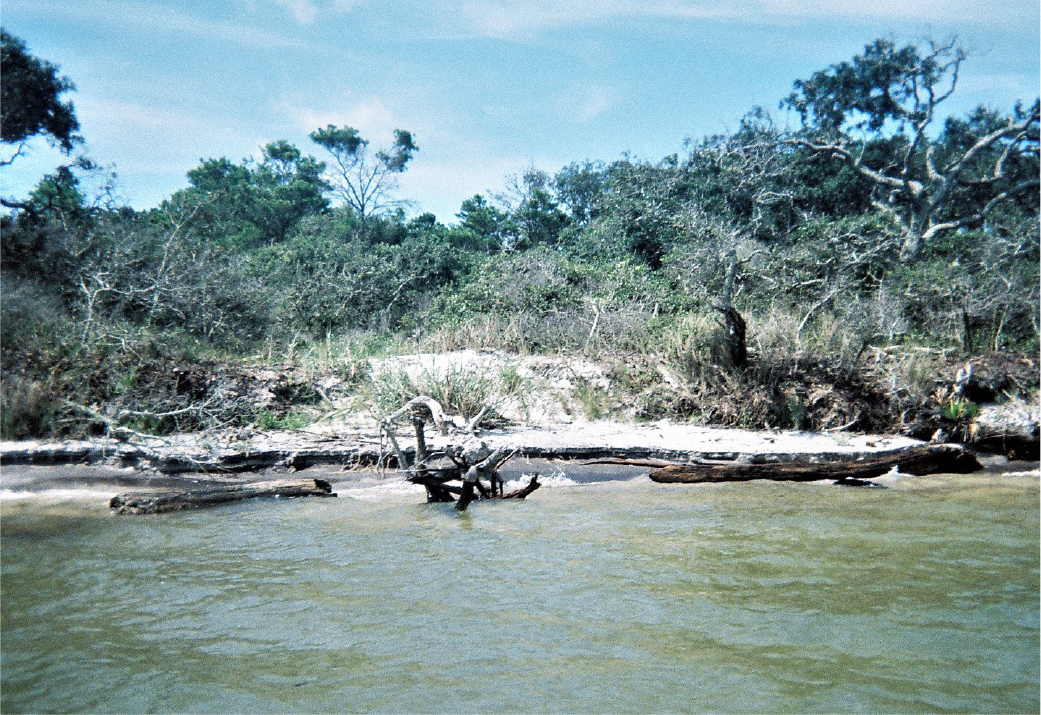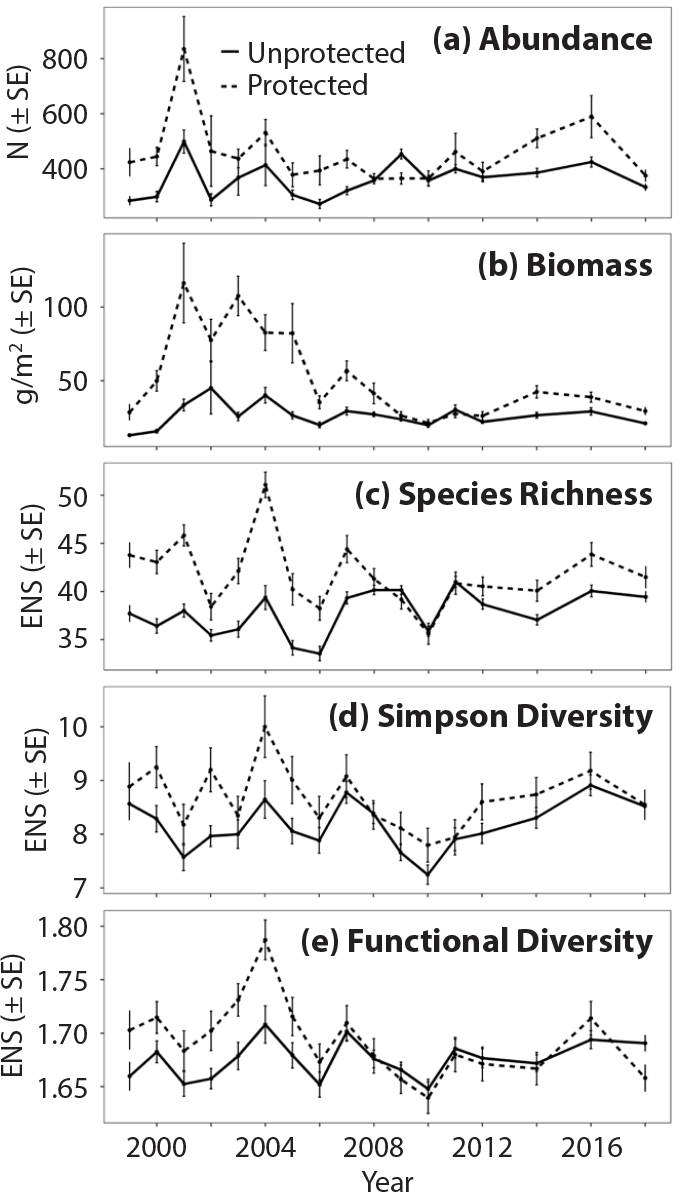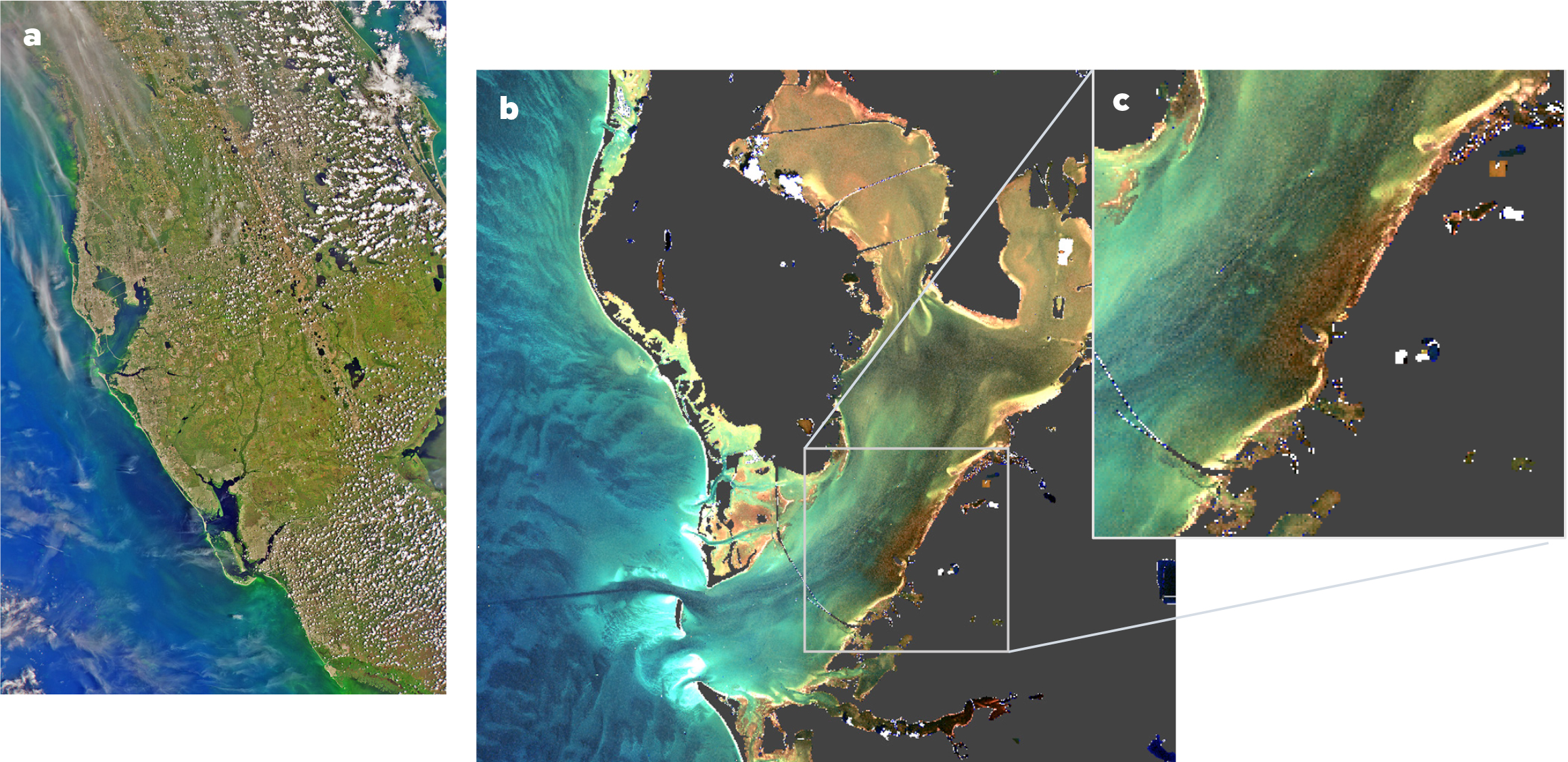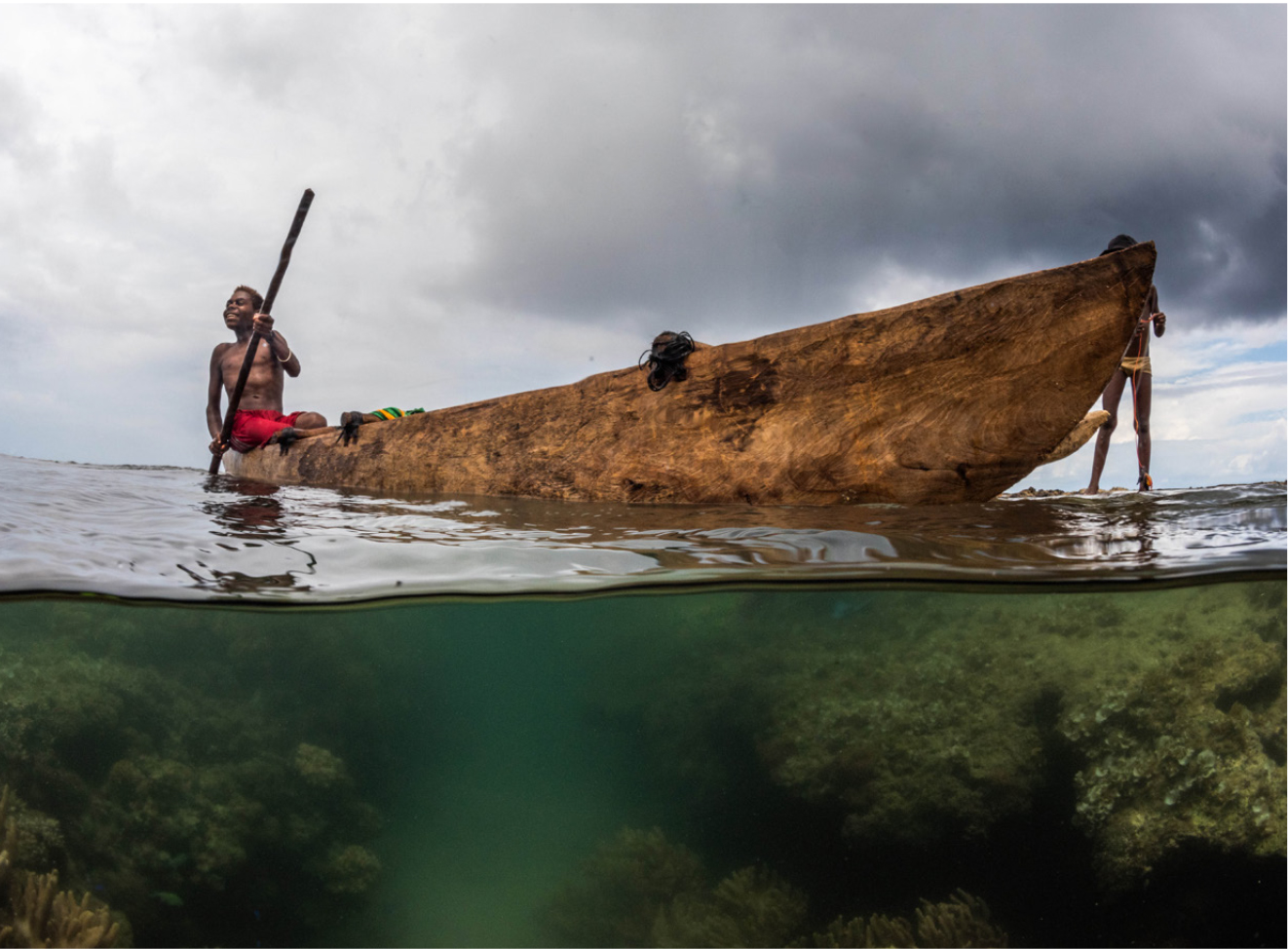Full Text
Introduction
The link between humans and life in the sea is not something most of us think about every day. However, we humans have historically built communities close to the sea, and we have studied how marine organisms grow, where they aggregate, and how their distribution changes throughout the day and with the seasons so that we can manage our activities to exploit them more effectively or protect them for other purposes. We use the sea for shipping and recreation, to extract energy, and to derive natural products such as medicines (Figure 1). These activities, when added to other industries, as well as research, technology, education, and governance, add up to about US$2 trillion a year. This “blue economy” is described as a knowledge-based economy in which data and information guide solutions to societal challenges (Spinrad, 2021). Similar to the way we built monitoring systems to improve global weather forecasting over the past 100 years, sustaining a blue economy now depends on a global ocean observing system to provide accurate and timely data about life in the sea.
|
|
A focus of Earth system science today is to improve forecasts of environmental variables so that we can predict the impacts of climate change and of human uses of the ocean. We justify much of this investment in research based on the need to protect life and property and to ensure food and water security. Over 90% of Earth’s habitable space is contained in the sea, and the habitats within it are rapidly changing. Sea surface temperatures have risen about 0.11°C per decade since the 1980s. Warming has led to sea level rise of about 3 cm per decade due to the thermal expansion of seawater and additional water entering the sea from melting glaciers. Warming has caused thinner sea ice and smaller ice shelves, with the minimum summer Arctic sea ice cover decreasing by an average of about 13% per decade. Meanwhile, the ocean has absorbed about one-third of the excess carbon dioxide humans have emitted into the atmosphere since the Industrial Revolution, causing an average decrease in near-surface pH of about 0.1 in the last 200 years, and twice that rate since the 1980s (–0.001 to –0.002 pH units per year documented at different ocean time series locations). There is also clear evidence of changes in salinity, oxygen levels, ocean winds, severe storm patterns, and major ocean currents around the globe (IPCC, 2021).
These environmental changes have altered the distribution, abundance, composition, and health of marine life in ways we are only beginning to understand, and this is stressing the blue economy and associated services needed by society. We depend on the ocean for food production; for some coastal communities, the ocean is the primary source of protein as well as an integral part of their cultural heritage. Conservation and effective management of marine resources are essential to ensure a sustainable blue economy. Current efforts to measure marine biodiversity and biology have neither the coverage nor consistency of ocean physical and chemical measurements. Improved understanding requires improved observations—we cannot understand or manage what we don’t measure.
Our knowledge about environmental changes is based on measurements collected around the world since the 1700s (Figure 2). While observing biology and ecosystems is the only way to make informed decisions about how to balance resource use and conservation, maps such as the one in Figure 2 show that the number of biological observations in any one region, and in most locations, is nowhere near what is needed to assess the status and rates of change of biological resources. We have an opportunity today to enhance the infrastructure needed to build the capacity to adequately observe marine biodiversity and biology, especially in coastal and pelagic areas of the world ocean where people most depend on these resources on a day-to-day basis.
|
|
Society’s Dependence on Information About Marine Life
The evolution of human society is intertwined with knowledge about marine biodiversity. Marine species shaped the ancient and current vision, culture, and heritage of many traditional and indigenous communities, from the tropics to high latitudes. Living marine resources that influence local, tribal, and national identities include the modern seafood gastronomy of Peru, the symbolic blue marlin in the Bahamas, and the sea turtle in Antigua, Barbuda, and many Polynesian cultures. Life in the sea provides many societies with a sense of place, occupational pride, spirituality, mental and bodily health, and security.
With 40% of the world’s growing population settled within 150 km of the ocean, the blue economy is expanding. Offshore energy, marine biotechnology, fisheries, pharmaceuticals, and tourism are growing. Global fisheries today land approximately 80 million metric tons (mmt) every year, employing some 30.6 million people. The marine capture for 2018 was 84.4 mmt based on data from the Food and Agriculture Organization of the United Nations. Up to 10% of the global population relies on fisheries for livelihoods. Mariculture produces over 38.6 mmt of seafood or US$67.4 billion annually, and this is growing quickly, with the potential for 700 times more production in the future. Similarly, global coral reef tourism is valued at US$35.8 billion annually and is expanding (Gaines et al., 2019). The Coral Triangle, located in parts of six countries (Indonesia, Philippines, Malaysia, Papua New Guinea, Solomon Islands, and East Timor) and the Mesoamerican Reef in parts of four countries (Belize, Guatemala, Honduras, and the Yucatán peninsula of Mexico), are estimated to contribute over US$20 billion to the blue economy from tourism, fisheries, and coastal development (Figure 3; UN Environment et al., 2018) Yet, at present, only a few locations around the world collect detailed data on the species compositions of different fisheries or the ages and life histories of fish and their prey and predators; on observations of essential habitats; or even on fish catches or socioeconomics in order to evaluate status and trends in biodiversity in the context of environmental changes or human activities (Figure 3).
|
|
Fish, other living marine resources, and the ecosystem services we depend on are sustained by many different species in coastal, shallow, and deep habitats. Seagrasses, mangroves, and macroalgal communities provide nursery habitat for finfish, shellfish, and many species of megafauna. Macrophytes (aquatic plants that grow in or near water such as cattails, hydrilla, water hyacinth, and duckweed) and hard coral reefs stabilize the coast and prevent shoreline erosion from tidal energy and storms, filter nutrients and pollutants in terrestrial runoff, trap sediments, and host significant wildlife. By 2100, approximately 630 million people worldwide could be at risk of coastal flooding caused by climate change and sea level rise without such protection. Access to sandy beaches is essential for sea turtles to lay eggs and for horseshoe crabs to create nests near the high tide line, which is receding rapidly in some areas (Figure 4).
|
|
The marine environment provides natural products that play critical roles in medicine and biotechnology. Many biochemicals have been isolated from marine species and can offer safer alternatives to cosmetics, anti-fouling agents, pharmaceuticals, and other products, including compounds with anticancer properties, and possible treatments for COVID-19. The blood of the common horseshoe crab, Limulus polyphemus, is the source of a compound that is used to test injectable medicines for microbial contamination (Sigwart et al., 2021).
Indeed, the inland economy, including the “green economy,” based on best practices intended to conserve energy and materials, is linked to the blue economy through industrial sectors, including production of fishmeal for poultry and other livestock and processing of algae used in many industries such as health, cosmetics, and renewable energy. Yet, the pollution that reaches the coast via rivers or other sources is at times unquantified in economic planning. We often use biological signals to measure downstream effects, such as microbial indicators for sewage contamination, or excess phytoplankton biomass or algal density to detect eutrophication. Beyond such bulk metrics, we lack biodiversity observing systems for tracking potential impacts to marine living resources and for monitoring ecosystem services around the world.
Conservation and Management: Requisites for Sustaining the Blue Economy
The ability to sustain economic growth and jobs requires making wise investments in conservation and restoring key coastal and marine resources. We cannot afford to continue to degrade the very resources our lives depend on through unsustainable practices. So, how do we guide wise stewardship and sustainable development? Designing a sustainable economy that is based on information and knowledge requires collecting basic observations from which we can develop indicators of ecosystem health, diversity, and productivity. The Global Ocean Observing System of the Intergovernmental Oceanographic Commission has advanced a framework for ocean observing based on collecting essential ocean variables (EOVs). In addition to physical (e.g., temperature and salinity) and biogeochemical (e.g., oxygen, inorganic and dissolved organic carbon) EOVs, it includes a family of biology and ecosystem EOVs (e.g., fish abundance and distribution, phytoplankton biomass and diversity; Miloslavich et al., 2018). This framework provides a coordinated scheme for observing the ocean and determining the fundamental indicators needed to guide decisions on sustainable development and restoration of coastal and ocean resources (Duarte et al., 2020).
Ocean financing and sustainable investing are key to developing the blue economy. Sala et al. (2021) find that protecting ~28% of the ocean could provide a net gain of 6 to 8 million metric tons of seafood, securing 35% of biodiversity benefits and 27% of carbon benefits. The High Level Panel for a Sustainable Ocean Economy concluded in 2020 that investments in such actions as sustainable ocean-based food production and conservation and restoration of mangroves would yield a fivefold return in global benefits (Stuchtey et al., 2020). Such investments would also cut annual greenhouse gas emissions and help reduce the rate of global temperature rise. While marine protected areas currently conserve and sustain ocean resources for the blue economy, additional research is required to determine their optimal design (Figure 5).
|
|
Many other examples of successes show what we can do. We must focus attention on promoting sustainability and equity in ocean uses, and address factors that impact women, informal workers, indigenous peoples, local communities, youth, vulnerable and disadvantaged populations, and early career professionals. Without careful attention to our actions, global economic losses may top US$400 billion a year by 2050, and US$2 trillion by 2100 (Stuchtey et al., 2020).
Monitoring Marine Ecosystems
In order to sustain the blue economy, observations of marine life must be integrated into global ocean monitoring of biology and ecosystem EOVs and include socioeconomic indicators. For example, at the base of the food chain, the dynamics of microbes and plankton control the locations of larger animals as well as their productivity and abundance. Many plankton species are harvested for protein and are also used in emerging renewable energy technologies. In addition, they are indicators of ecosystem health and water quality, and they are the “bio” part in biogeochemical cycles that we need to better measure as we engineer a low-carbon economy. Effective monitoring of plankton is possible today through investments in genomic, optical, imaging, active and passive acoustics, and remote-sensing methods that would improve forecasts for managing food production, water quality, and carbon sequestration (Estes et al., 2021).
At the other end of the size spectrum are marine megafauna (turtles, birds, mammals, and large fish are grouped in a broad category of EOVs), organisms that function as top-down controls on ecosystem structure and function. Their migratory routes and associations with other multi-species networks often mark marine corridors and biodiversity hotspots. Understanding where and when these corridors and hotspots form, how they are changing, and how they are beneficial to us is key to management of shipping, fishing, mining, and land or vessel discharges.
New observing tools include sensors on satellites, aircraft, and autonomous underwater platforms. Using such “remote sensing” of biology and ecosystems expands the scope of traditional observing platforms like ships and buoys, permitting sustained and repeated synoptic mapping of entire ocean basins.
Satellite sensors collect important measurements across the marine realm. In addition to helping to locate and track tagged animals, the many environmental parameters they collect, such as chlorophyll-a concentration and seawater color, permit definition and evaluation of phytoplankton habitats and traits. Today, remotely sensed data collected by NASA’s Moderate Resolution Imaging Spectroradiometer (MODIS) and the European Space Agency’s Sentinel-2 and Sentinel-3 satellite sensors, among others, provide global coverage and finer-scale data that allow observations of coastal biological signals (Figure 6). New missions expected to bring major advances in ocean imaging include NASA’s Surface Geology and Biology (SBG, expected to launch in 2027), Plankton, Aerosol, Cloud, ocean Ecosystem (PACE, scheduled for launch in 2023), and Geosynchronous Littoral Imaging and Monitoring Radiometer (GLIMR, 2026–2027). Satellite lidar systems are detecting phytoplankton and zooplankton deeper in the ocean at night and in winter at high latitudes and are characterizing the seafloor topography of coastal habitats. Combined with satellite measurements of winds, currents, sea surface topography, salinity, and temperature, a relatively coherent set of global seascapes can be visualized and analyzed nearly daily and over long time periods. Improved consistency and relevance in interpreted remote-sensing products requires expanded in situ calibration and validation, and greater interaction with biological sampling communities.
|
|
Monitoring of coastal nearshore environments is challenging due to their dynamic nature, but necessary because the resources they contain are valuable to the blue economy. Expansion of urban and agricultural land use directly affects nearshore water quality, increasing nutrient and sediment runoff that results in eutrophication (Boesch, 2019) and algal blooms that can harm marine life and release airborne toxins into nearshore areas. Monitoring seagrasses, mangroves, and macroalgae (kelp, Sargassum, green and red algae) is critical because of their foundational role as habitats for many species of commercial, subsistence, and conservation interest worldwide (Estes et al., 2021). In addition to the Global Coral Reef Monitoring Network, the global Mangrove Alliance, the Reef Life Survey, the Partnership for Interdisciplinary Studies of Coastal Oceans (PISCO), and other entities focused on systematic and distributed surveys of nearshore habitats at large scales, development of citizen scientist approaches is needed to support these and related data collection efforts.
New ways to rapidly transmit data, as well as to collect and process images and environmental DNA (eDNA), improve our knowledge of changes in the distribution and abundance of life in the ocean, including those caused by warming. Combining these advances in technology with improved satellite and in situ observations of primary producers (e.g., phytoplankton), primary consumers (e.g., zooplankton, small fish), and overall environmental conditions (e.g., climate variables) means that we are now able to track these changes and better understand their drivers. Combining observations requires greater collaboration among different research areas and with local stakeholders.
All of these biological observations can be incorporated into existing ocean observing programs that focus on the physics, chemistry, and geology of the ocean, including the global effort to map seafloor topography (Seabed 2030 project), the Global Ocean Ship-based Hydrographic Investigations Program (GO-SHIP), and OceanSITES. Taking Seabed 2030 as an example, its use of active acoustic sound wave reflection measurements to map the topography of the global ocean seafloor can be complemented with initiatives to collect water column and seafloor acoustic backscatter data that provide information about fish, plankton, and bottom habitats across ocean basins, repeatedly over time. Passive acoustic technology is now feasible and accessible to conduct scientific monitoring of different species, from small zooplankton to birds, and from fish to marine mammals (Figure 7), and human noise, from the bottom of the ocean to shallow reef environments. The benefits of such information for academic science, government, the private sector, and the public are substantial. Greater collaboration will depend on multinational and national groups contributing standardized biological data to enable forecasting and global assessments, similar to what we have already accomplished with weather and climate assessments. This could provide the basis for a revolutionary new marine biodiversity observation network to support a sustainable blue economy.
|
|
Capacity Development
Capacity development as well as incorporation of education and outreach in marine biodiversity monitoring are fundamental to sustaining and growing the marine economy and reducing inequities in access and opportunity. Broad and innovative multisectoral and interdisciplinary approaches are needed to enhance public understanding of biodiversity and fundamental ecological benefits, to improve ocean governance, and to design better green-gray infrastructure (natural systems such as forests, floodplains, and wetlands as opposed to human-engineered infrastructure such as dams, seawalls, and roads). It is also essential that we better coordinate and assess capacity development initiatives internationally. Programs like Marine Life 2030 and the Ocean Biomolecular Observing Network, endorsed by the United Nations Decade of Ocean Science for Sustainable Development (2021–2030; also known as the UN Ocean Decade), provide the framework for developing shared objectives and distributed leadership.
Capacity building needs to be reinvented to focus on developing partnerships that engage traditional leadership and communities in the management of their marine resources (Figure 8). For example, The New England Aquarium’s Marine Conservation Action Fund awards micro-grants to local leaders in developing countries to advance marine conservation and partnership with local communities. Another example in science diplomacy is the effort of the government of Palau to educate visitors by requiring them to sign a pledge to act in ecologically and culturally responsible ways on their islands.
|
|
Early career professionals, those in the 55% of the world population that is under the age of 35, face challenges following the COVID-19 pandemic, as well as geopolitical tensions, social unrest, global trade barriers, and issues of equity and inclusion in academia, industry, and government. We have an opportunity to engage these young professionals’ talents to support ongoing observation needs, especially in underdeveloped regions with rich marine resources (Figure 9). However, the rapid pace of technology evolution, limited availability of documentation in different languages, the high cost of printed media, inadequate access to high-speed internet, and limited access to education present challenges. Historically, these disparities diminished the ability of women and underrepresented minorities to become leaders in oceanography. A new paradigm is needed in which government, academia, and the private sector collaborate to create jobs and improve conditions for the most vulnerable communities, thereby allowing diverse professionals to develop and apply their competencies.
|
|
Linking Local to Global Structures to Provide the Foundation of the Blue Economy: Data
A healthy blue economy relies on timely delivery of high-quality data across sectors, including science, operations, policy, and the public, from local to global scales. Needed information about marine life is identified by research groups; local, tribal, and national governments; and global bodies advising on areas as diverse as climate, biodiversity, ecosystem health, and the scientific perspective. Synthesis of indicators and knowledge at every governance level requires open access to data on relevant biology and ecosystems collected in different locations and using standardized formats.
Global groups that are helping to organize the sustained, systematic collection of these data include the Intergovernmental Oceanographic Commission (IOC) and the Group on Earth Observations (GEO). The IOC hosts the Global Ocean Observing System, which defined the EOVs, and also a global Ocean Biodiversity Information System database for marine species (OBIS), the Ocean Teacher Global Academy (OTGA) to share knowledge and build capacity, and the Ocean Best Practices System (OBPS). These entities link programs by storing and curating standard operating practices and methods, data, and capacity development modules. They facilitate interoperability for the exchange of data between machines, share analysis and visualization software, and support global inclusion, all with positive impacts in areas beyond marine science.
These programs should coordinate with capacity building programs in universities, museums, and aquariums, as well as training programs sponsored by other groups including private foundations and civil society. The growth of the blue economy brings opportunities for official development, philanthropy, and industry investments in programs to observe marine life and apply sustainable practices that yield economic benefit and create jobs. Initiatives such as the UN Ocean Decade and the Decade for Ecosystem Restoration, plus the complementary programs they house such as Marine Life 2030, the Ocean Biomolecular Observing Network, UN-Maritime Acoustic Environment, and Marine Protected Area Sentinels, are intended to steer such investments and meet the observing needs for marine life in the new blue economy. Impact will require the delivery of knowledge in appropriate social and cultural contexts.
ACKNOWLEDGMENTS

